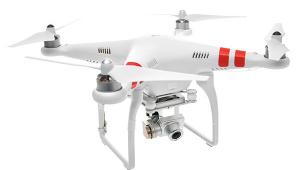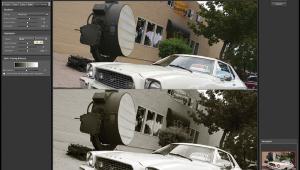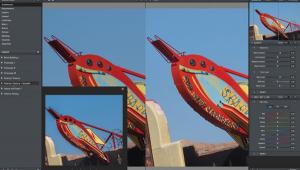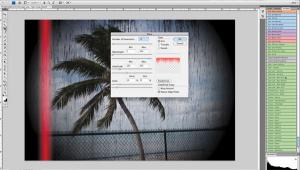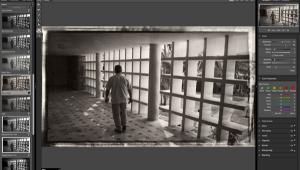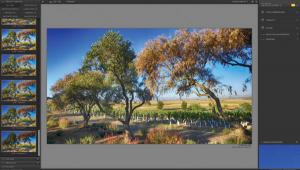Digital Innovations
Browsers And Other Useful Digital Imaging Software
| "The major difference between a thing that might go wrong and a thing that cannot possibly go wrong is that when a thing that cannot possibly go wrong goes wrong it usually turns out to be impossible to get at or repair."-- Douglas Adams (1952-2001) This quote perfectly describes the condition of my main digital imaging computer, an Apple Power Macintosh G3 (a.k.a. Crunch), who in recent weeks has had as many hard drives installed as you can shake a boot at. For the past several days he's worked without incident, and I hope this good luck continues. Windows users who are feeling smug about these comments should realize that the current horror stories vis a vis my Windows Millennium computer are just as bad. As I began writing this column, I learned that Douglas Adams had passed away. He was, as many of you know, the author of The Hitchhiker's Guide to the Galaxy, and a writer who knew how to turn a phrase. I never met Adams, but his humor and wit influenced both my writing and philosophical outlook. He will be missed. Browsing Away For many years Netscape Navigator was the browser of choice for my Mac OS and Windows computers, but all that changed with the introduction of Internet Explorer for Macintosh 5.0. I believe this product is the best browser available for Macintosh users, and if you don't believe me, download a copy (www.microsoft.com/mac) and see for yourself. It's surprising how little the Mac OS version resembles the one shipped with Microsoft's Windows Millennium operating system. Microsoft (www.microsoft.com) is currently offering a free download of Internet Explorer 6.0 Preview Edition, which still looks a lot more like Version 5.5 and not much like the more functional Macintosh version. By the time you read this, Internet Explorer 6 will probably be more stable than the crash and burn version I've been working with. I just installed a beta copy of Microsoft's Office XP on my wife Mary's Premio Calypso computer (www.premiopc.com) that is running a beta of the Microsoft Windows XP operating system (see Shutterbug, August 2001) and it even has a different version of Internet Explorer. One of the problems with the Big Two browsers is that, over time, they become bloatware; engorged with so many features they become slower and less responsive, especially when used on a dial-up basis and not the broadband access the developers probably used to design the software. Downloading Netscape Communi-cator, for example, took me over 90 minutes using a 56K modem. That's one reason why browsers like Opera (www.opera.com) were developed. It is smaller and more responsive than the competition. At only 1.8MB in size, Opera will run on older computers such as the Intel 486 box you can't bear to throw out because it's the first computer you used to download Doom. Now may be the time to turn it into a browser box for someone else in the family. Opera requires little RAM and can open multiple windows without running out of memory. If you'd like to customize the look of your tool bar, Opera is customizable. If you don't like cookies, (and I'm not talking about www.mrsfields.com) one click turns them off. Advanced cookie filtering allows you to specify which cookies you will or will not accept.Best of all, Opera is robust. There is an alarming trend for many photographic companies to use splashy Macromedia Flash animation on the first page of their web sites. When my Windows version of Internet Explorer encounters these kinds of pages, it crashes. That's when I reach for Opera 5, which glibly handles whatever splashy homepages these companies feel obliged to use. Opera can retrieve multiple documents and images at the same time. Documents load faster and, instead of waiting for a single document, you can browse in another window. Opera's special download window has items like download resume, so if your machine crashes, the browser picks up where you left off. If this has piqued your interest, you should visit their web site. I know some Macin-tosh users choose to avoid Microsoft products, but I don't feel that way. If you do, Opera is available in Mac OS, as well as Windows, Linux, and the Be OS, too. Although there is a free version of the program, it displays commercial ads, albeit in a small area much like the Juno (www.juno.com) e-mail client. The company offers a $39 version that doesn't display ads; I leave it to you to decide if it's worth the modest fee. Even in this cross-platform world there are still single platform browser alternatives available. FlipBrowser from E-Book Systems (www.flip browser.com) is available in Gold and (free) Standard versions for Microsoft Windows, while the Mac OS-only iCab (www.icab.de) from Germany is expected to be available in a free and professional version that will sell for less than $30. A Big LCD Monitor For Browsing If you're used to working with glass CRT monitors, you will discover that LCD panels need to be set up somewhat differently. When working with flat panel monitors larger than 15", text can appear fuzzy. There are a few adjustments you can make with Windows computers to make dramatic improvements in text sharpness. If the monitor's clock and phase adjustments aren't right, it can make text look choppy. Clock and phase are easiest to adjust by going to Windows' Start menu, selecting Shut Down (but not confirming shutdown) and leaving the window asking for shutdown or restart active. If you see "bars" across the screen, make a few adjustments to the monitor's clock and phase OSD (On Screen Display) controls until they disappear. Then, select Cancel in the Shut Down window and go back to the desktop. Another factor that can cause text degradation is when contrast is set too high, so be sure to check that, too. Plug-In Of The Month The Perspective Filter includes a library of presets, but most users will just grab the image with their mouse and fling it about in virtual 3D space. You can rotate your digital images through 360 in any direction and Bryce-like control arrows can be used for fine-tuning. While you can use the Perspective Filter for photographic special effects, it should also be a useful tool for working with text to create interesting titles for a web site or promotional material. To download a trial copy and find out more information about the Perspective filter, or any of Andromeda's other interesting plug-ins, visit their web site at: www.andromeda.com. Mac OS Image Management
Tool There are four ways to view image files with MediaPro:
Each of these views can be customized and used for printing, web pages, or export functions. You can annotate, label, categorize, find, and search files using any criteria, including user-definable fields. iView MediaPro can make web galleries from photos, illustrations, and video clips and can print contact sheets or full images. In download form, MediaPro costs $45 or you can get a CD-ROM for $90. Right now this is a Mac OS-only product and is compatible with OS 9. An OS X version with Aqua interface is promised, as well as a version for users of Microsoft Windows. This is one time Mac owners can say, "eat your hearts out" to Windows users. For more information and to download a trial version, visit www.iview-multimedia.com. Making Digital Albums Paper For Your Ink Jet Printer |
